Ted Trueblood: Reflections on a Western Legend
by Russell Chatham Introduction by Mike Toth Ted Trueblood was a man who lived his life the way that so...

by Russell Chatham
Introduction by Mike Toth
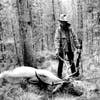
Ted Trueblood was a man who lived his life the way that so many of us fantasize. He made his living by doing three things: hunting, fishing, and writing about the first two things. His is one of the most impressive legacies in outdoor journalism, made all the more remarkable because he was so humble and unpretentious.
A writer for Field & Stream from 1939 until his death in 1982, Trueblood was Fishing Editor for several years, and was even based in New York City for a time. But his native Idaho called him back home, and that’s where he took his new title of Associate Editor, writing many hundreds of stories that captivated readers with a unique blend of clarity, information, entertainment, and modesty. Whether he was writing about elk or bluegills, pronghorns or steelhead, grouse or bass, he focused on the message and the experience, not on his success. He was a masterful all-around outdoorsman who understood that catching and shooting was only a small part it, and a talented author who wrote volumes but never with an unnecessary word.
The world will probably never see another Ted Trueblood.
And for a time, many in the world thought there wasn’t even one of them.
In 1962, Ed Zern wrote what editors thought would be an obviously humorous Exit, Laughing column in Field & Stream that told how editors had sat around the office one day and fabricated Ted Trueblood out of thin air — a man with an earthily fanciful name who fishes and hunts all over the country and is an expert in all things outdoors.
He has a pretty wife and two handsome kids and a smart English pointer, all of whom hunt and fish with him.
He’s a smart, caring man.
He’s just a terrific writer.
He lives in Idaho.
Scores of outraged subscribers wrote letters to the magazine, demanding refunds. They has misunderstood Zern’s column because it was so easy to believe that Ted Trueblood was, simply, unbelievable.
Renowned landscape artist and consummate outdoorsman Russell Chatham greatly admired Ted Trueblood from childhood. Here, in a story first published in Big Sky Journal (and which is brilliantly arranged as an homage to Trueblood’s writing; you’ll notice a hint to this halfway through) Chatham tells how, as an adult, he finally got to meet the man who always seemed too good to be true. —M.T.
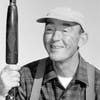
When I first encountered the name Ted Trueblood, the name itself — unusual, theatrical even, especially in context — suggested reliability. In those days there was a popular men’s adventure magazine called True. It was not a fishing and hunting magazine, but each issue usually carried a story or two about one or the other. Many were by Trueblood. Trueblood tells the truth in True.
To be an outdoor writer in those days, it was also necessary to be a photographer. A story about muskie fishing in Leech Lake would necessarily feature a dozen pictures of various aspects of the trip, not the least of which would be the writer holding up his biggest dead muskie. Trueblood’s articles with their requisite illustrations never seemed to picture the author. Twelve or thirteen years old at the time, eyes and ears peeled for possible stuff of mythology, my friends and I talked about whether or not there actually was a Ted Trueblood, or whether the name was dreamed up by someone at True just because it sounded good.
Then one day he arrived at the Russian River just north of San Francisco. We never actually saw him, but word had it that he was shad fishing, which was what we were learning to do. And he was fishing with all the local experts, people like world casting champions Myron Gregory and Jon Tarantino, Doug Merrick from the Winston Rod Company and Bill Schaadt, who, even in 1952 was already a legend based on his intensity and consummate skill.
The following spring, Trueblood published his story, and it was about Schaadt the man, and shad the fish, both pronounced exactly the same. There were pictures of fishermen wading in the Fife Creek pool, shots of jumping shad, of Bill casting. But again, not a glimpse of the author. I was sufficiently convinced the man now existed, but I wanted to see what he looked like.
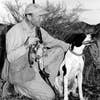
A few years later, we had the first of what was to become a succession of dry years in California, a phenomenon which created a new wave of dam building in the state, including the one which doomed the Russian. It was the winter of 1955, and all through the fall and into the winter it didn’t rain. The steelhead came in, starting much earlier than normal. On my birthday, October 27, the day I got my first driver’s license, I left home before dawn, arriving in my first car at Duncan Mills shortly after dawn hoping to find a grilse or two in the riffle above the bridge. Instead, I found the river loaded with big steelhead. Although I hooked several, they tore me to pieces, and I never even came close to catching one.
At that time, there was a character around the Bay area who started the first Fishing News, a weekly tabloid. He also had a short radio program on which he would announce in the staccato style of Walter Winchell where all the various fish were biting. His name was Al Accardi, and he billed himself as “The Fishfinder.”
I was still in high school, so I could only get to the river on weekends. On one of his midweek shows, he was raving on about the thousands of steelhead fishermen were catching. We knew for a fact that some hardcore locals like our neighbor Earl Crawford, known on the river as “The Snake,” were catching three or four limits a day on flies, a limit being three fish. And Earl wasn’t even a fly-fisherman. Accardi went on at length about how Bill Schaadt had one on almost continuously from dawn until dark, day after day. He added that the fishing was so hot that it had brought Ted Trueblood out from his home in Idaho to fish with Bill.
On Friday night, I left for the river as usual, only this time my anticipation was fueled by the fact that the next day I was going to see Ted Trueblood with my own eyes.
In the morning, I drove into the secret little road to the north of Watson’s Log Hole where Schaadt’s 1937 Dodge was already hidden in the trees. I waded the riffle and walked upstream. I could see Bill even at a distance because he was wearing a very visible red and black checkered coat. He was rowing his beautiful ten foot flatbottom wooden river boat to shore with one hand while his other held a curved, living fly rod.
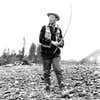
As I approached, he reached shore and jumped out to play his steelhead. A small group of men were standing by a fire drinking coffee, warming themselves and watching Bill. I, too, wanted to watch the master of masters, the expert’s expert. At the same time, I looked for Trueblood. He couldn’t be among this crew of slouching duds watching instead of fishing, but though there were several boats still out in the pool, I could see all were bait or lure fishing.
“That damn Schaadt,” one of the men said. “How the hell does he do it? He brings one fish in, lets it go, then rows out and, two casts later, he’s got another one.”
Another added, “And that Trueblood who was here all week fishing with him was close to keeping up. You never seen anything like it.”
I barged in, “Where is Trueblood?”
To which one of the men answered, “Heard he went home yesterday on account of he didn’t want to fight the weekend crowds.”
Cecil Whitaker Trueblood was born in Boise, Idaho, in 1913 and was raised on a farm nearby. The nickname, Ted, was probably a family habit that stuck. Early on, he must have been drawn to the craft of writing because he sold his first story to National Sportsman Magazine in 1931, the year he graduated from high school. It was called “A Certain Idaho Trout.”
The editor of the magazine, Edmund Ware Smith, himself a popular outdoor writer, published it under the byline, “J.W. Wintring,” insisting that Ted Trueblood “was a nom de plume, and not a very good one at that.”
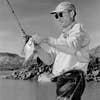
Throughout his career, succeeding generations of readers would continue to question the reality of his very existence. He continually placed his ego in the shadows and maintained the habit of only rarely allowing a picture of himself to get into print; even then, it was usually at some odd angle or, more often, from the back.
A legend grew up around Trueblood’s writing, and it was not uncommon for readers to write to True or to Field & Stream, where he wrote a column each month for forty-one years, suggesting that a team of ghost writers was responsible for his work. Ted did have a well developed sense of humor, and at one point he wrote a column denying his own existence.
In the very best sense of the word, Ted Trueblood was an expert. He was an expert hunter, fisherman, woodsman, conservationist and writer. The outdoors relative to the press have always spawned experts, only a small handful of whom have been genuine. For instance, during Trueblood’s career there were a number of other popular hunters and fisherman such as Jack O’Connor, Fred Bear, Robert Ruark, Ernest Hemingway, Lee Wulff, Jason Lucas, A.J. McClane and Joe Brooks. Among this crew, however, one is routinely overwhelmed with posturing, braggadocio, glamour, social position and self-importance. And, with the exception of Hemingway, a decided lack of interest in literary style or grace.
Trueblood was unglamorous, had little money, lived modestly, and took his work seriously. At the same time, he never took himself too seriously, and always maintained a sense of playfulness and a sense of humor.
Although from quite different backgrounds, you can define some real similarities between the life and work of Trueblood and that of Roderick Haig-Brown. Both viewed the practice of writing with appropriate respect and humility. Both lived full, whole lives in locales where the environment was wild and intact, where, in those saner pre-jet set times, they mostly stayed close to home; if they drove someplace, it was only for a reasonable distance. And while enjoying the sporting fruits of their respective home grounds — rueblood in Idaho, Haig-Brown in British Columbia — throughout their lives they built an abiding understanding of their local creatures and habitat, in the process becoming what we call environmentalists at a time when this concept enjoyed no popularity whatsoever.
Trueblood lacked the formal, classical training Haig-Brown received in England, but nonetheless he esteemed the craft of writing and was concerned with clarity, grammatical correctness, formal essay structure, vividness, rhythm and pacing. He also understood the emotional building which leads the reader line by line, paragraph by paragraph, toward an inevitable conclusion.
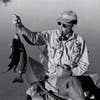
Not long ago I read through a large part of Trueblood’s oeuvre—over a thousand stories.
One I came across was about a deer hunt during which Trueblood follows the movements of a deer herd—and one big buck in particular—over a period of several days. The story is about the essence of hunting, which is looking, hearing, following, waiting, anticipating and understanding. At the very end, the buck steps out of the aspens right where Trueblood figured he would, and the story ends with him lining up the crosshairs.
I vaguely remembered reading this when I was a teenager, and it occurred to me that a story I wrote about tarpon fishing in the Keys was unconsciously patterned after it. In my work, everything revolved around what led up to the fish biting the fly, at which point the story ended.
Trueblood frequently said he did his best work while in the field. He wrote in a notebook, sometimes in a hunting tent, sometimes sitting out under a tree. This way, if it was a story about something that just happened, events were at their freshest. But if he was writing a philosophical rather than instructional, practical or narrative essay, he still maintained he was most focused and at peace in the wild, and that a pencil was a more appropriate tool than a typewriter.
After high school, Trueblood attended the College of Idaho, and then the University of Idaho in Moscow. Following that, he returned to Boise and began working as a reporter for the Boise Capitol News. While there, he met his future wife, Ellen, who was also a reporter for the paper. In 1936, while still in Boise, he played a major role in organizing the Idaho Wildlife Federation, the start of a lifelong interest in conservation.
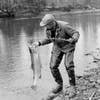
In 1937, he went to work for the Deseret News in Salt Lake City, and at the same time began selling articles to Field & Stream. He and Ellen were married in 1939, and for the next two years Ted tried earning his living solely by freelance writing. Even coming out of the Depression, this was a tough assignment. He and Ellen were on a first-name basis with hand-to-mouth living, and he wrote about it in a story wherein he discussed wild duck recipes. Things were so close to the bone, they were eating the ducks Ted shot in the morning for dinner every night until they could hardly bear to look at another. Still, late in life, Trueblood was quoted as saying, “If I had my life to live over again, I’d spend more time hunting and fishing and less struggling around for low wages.”
In the early forties, Trueblood was asked to become the fishing editor of Field & Stream. Tired of just scraping by, he accepted. Of course, this meant moving to New York, where he and Ellen lived just outside the city for several years. The story is that one day the Truebloods’ neighbor keeled over and died of a heart attack while shoveling the snow off his driveway. He had been a hardworking man who had been saving all his life for retirement.
At that, Trueblood immediately reassessed his life, then announced he was going back to Idaho where he was going to do nothing but fish, hunt and write about it. The publishers urged him to stay on, but he refused, so they made him an associate editor, and from 1947 until his death in 1982, he wrote a monthly column for the magazine from his home in Nampa, Idaho.
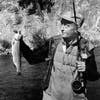
As time passed and the population of the country grew larger and larger, Trueblood recognized that when he wrote about a particular place, the immediate effect was to send in a crowd. Unlike so many of his contemporaries, he was sensitive to this, recognizing that his own explicit enthusiasm could literally devastate the quality of a particular hunting or fishing locale.
Back in the early sixties, Trueblood discovered a little known run of huge steelhead. This time, there were in-your-face pictures galore, the most impressive and astonishing of which featured Trueblood himself in full Kodachrome, holding a twenty-pound fish. In the story, he refused to divulge the locale, creating somewhat of a flap in the angling community. And although True was deluged with letters and phone calls, Trueblood never did reveal the vital information.
In the arena of gear, Trueblood was spare and sensible. In our era where goods have become the point, Ted’s things were the bare bones of practicality, a gleaming example of how simplicity shines the brightest. Yet he knew the quality. His camera was a Leica, his shotgun a Remington pump, his rifle a Winchester model 70, his fly rod a Winston, his reel a Hardy Perfect.
He who would be an expert must first know that other experts before him have important information. Trueblood knew this, and when he developed a serious interest in fly-casting, he went to San Francisco where it had been raised to its highest level. He got an assignment to do a story about Lew Stoner and the R.L. Winston Rod Co. for True magazine, knowing that every casting record in the world was set with a Winston Rod.
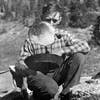
The kind of steelhead and salmon fishing practiced on the Russian, Gualala and Eel Rivers in northern California was entirely a matter of distance casting. Trueblood understood that he who casts farthest casts best. At first glance, this may seem a rather crass concept, especially to a spring creek fisherman used to presenting small flies at twenty feet with great accuracy. But the fact is as speed and power increase, as they do in distance casting, mistakes in trajectory and timing are magnified. Every world champion distance caster has always held all the accuracy records as well. The often-heard remark that most fish are caught on short, accurate casts has validity, but is irrelevant to what constitutes world class fly-casting.
Trueblood gravitated toward Stoner, whom many considered the best rod builder ever, and toward the champions who set the phenomenal records, foremost of whom was Jon Tarantino. He also befriended Myron Gregory, a world champion and the man who devised the system of numbering fly lines according to weight rather than diameter, which is universally used today.
Along with his tangible expertise, Trueblood maintained a lifelong enthusiasm for environmentally sound ideas, groups and projects. It would require a page just to list his distinguished service awards. In the end, what matters is that he was a man who cared and then acted upon those cares.
In 1973, the year after I moved from California to Montana, several friends drove up for a summer visit. They were Grant King, Bob Nauheim, Frank Berraina and Bill Schaadt. We fished all around the area for a month or so, ending up at Henry’s Lake. It turned out that Trueblood and Barrett were there fishing too. Bill was anxious to see his old friend and somehow arrangements were made for all of us to meet for dinner in West Yellowstone.
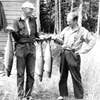
As the hour neared, I tried to remain casual, but the years of intense admiration would not allow it. Bill Schaadt, who Trueblood said taught him more about fishing than anyone he’d ever known, had by this time literally become my surrogate father, and he was about to introduce me to the man I next admired most, someone I once thought didn’t exist.
But exist he did, and in his devotion to the craft of writing—applied to the natural world which he lived, breathed and loved with all his heart—he elevated what we have come to call “outdoor writing” to the highest, cleanest level to which it has ever been taken. He gave his craft a simple dignity and honest, which brought him the respect, love and admiration of all his following.
When the two men entered the far end of the room, I remember thinking they seemed somewhat smaller than they should be. As they approached, I looked hard at Trueblood. There was a calmness there, along with the slightest smile. Tears tend to blur things, but I could still see his red wool coat as I heard Bill deliver an introduction. When I felt his hand close around mine I looked up, but his face was completely indistinct.